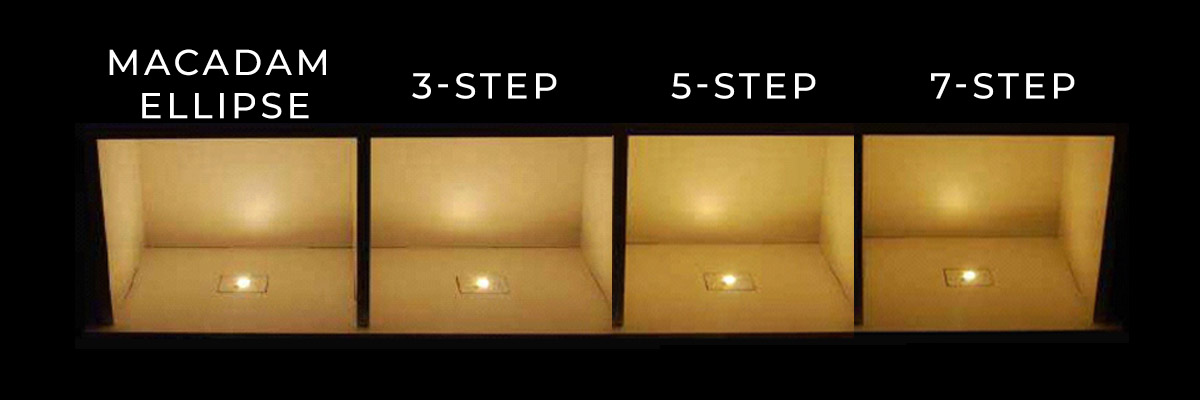Understanding LED Color Consistency: The Crucial Role of Macadam Ellipse Sorting
- By Lumistrips LED Professional
- Nov 17, 2022

The world of LED technology is continually evolving, transforming the way we illuminate our homes, offices, and outdoor spaces. One crucial factor often overlooked in LED lighting is color consistency, which can significantly impact the visual appeal and functionality of the lighting design. In this comprehensive guide, we'll delve into the importance of color consistency, and unravel the mystery of Macadam Ellipse sorting in achieving a uniform LED color output.
The Significance of LED Color Consistency
LED color consistency is paramount in determining the quality and aesthetic appeal of a lighting application. It refers to the uniformity of the hue emitted by different LEDs in a lighting fixture. In a scenario where color consistency is compromised, the shade of white light may vary noticeably from one LED to another, as depicted in the image below.

On the contrary, high color consistency ensures all LEDs emit the same hue of white, resulting in a harmonious and pleasing lighting effect. But how do we achieve this uniformity? The answer lies in a concept known as Macadam Ellipse color sorting.
The Spectrum of White Light
Before we delve into LED sorting, it's essential to understand the spectrum of white light. White light doesn't come in a 'one-size-fits-all' variant; instead, it spans across a range of color temperatures measured in Kelvin (K).
While there's no universally accepted definition, typically, warm white light for LEDs falls within 2500K-4000K, pure white ranges from 4000K-5000K, and cold white spans 5000K-10,000K.

However, owing to production variances, even LEDs within the same color temperature range can emit different shades of white light. For instance, Nichia warm white LEDs fresh from the production line can have a color temperature between 2580K and 4260K. Incorporating these LEDs directly into luminaires without sorting would result in noticeably inconsistent color temperatures, rendering the lighting unfit for most applications.

Chromaticity Bins and LED Sorting
To counter this color inconsistency issue, LEDs are sorted into groups known as "chromaticity bins." Each bin represents a range of color temperatures, and LEDs within the same bin share similar color characteristics.
Let's consider the example of Nichia, an LED manufacturer that categorizes warm white LEDs into four distinct chromaticity bins: SM27 (2580K-2870K), SM30 (2870K-3220K), SM35 (3220K-3710K), and SM40 (3710K-4260K). Each of these bins is further divided into numerous sub-bins to achieve an even more refined color grouping.

Macadam Ellipses and LED Purchasing
The concept of Macadam Ellipses is instrumental in LED purchasing. It refers to the selection of LEDs from specific manufacturer-sorted chromaticity bins. However, one doesn't have the luxury of cherry-picking any bin or sub-bin they fancy. Instead, a minimum of three bins must be selected, creating what's known as Macadam Ellipse LED sorting, which can be 7-step, 5-step, 3-step, or without sorting.

To illustrate, let's consider the 5-step MacAdam Ellipse Sorting. In this method, you select a bin symbol and request five consecutive bins. For instance, if you choose the SM27 bins, your delivery will consist of five randomly selected bins, provided they fall within a subset of five consecutive bins from the deck. This sorting method typically results in a 5-10% price increase but ensures satisfactory color consistency for many projects.
On the other hand, a 3-step MacAdam Ellipse Sorting involves choosing a bin symbol and requesting three consecutive bins. Using the SM27 bins as an example again, your delivery will include three randomly selected bins, as long as they fall within a subset of three consecutive bins from the deck. This sorting method almost eliminates visible differences in color temperature, ensuring superior color consistency. However, it comes with a 20-30% higher price tag.
For projects that can tolerate visible color temperature differences, such as street lighting or Christmas lighting, the 'Bin Only' option is suitable. Here, you choose only the bin symbol, and your delivery will consist of a completely random set of bins within the specified range. This option is the most cost-effective, but it doesn't guarantee color consistency.
At Lumistrips, we prioritize LED color consistency in all our products. We use LEDs sorted using the 3-step MacAdam Ellipse method, ensuring the highest possible color uniformity across all lighting fixtures. Additionally, we offer a wide range of color temperature options, catering to varying aesthetic preferences and lighting requirements.
The Role of Macadam Ellipse Sorting in LED Color Consistency
Macadam Ellipse sorting is a crucial tool in achieving LED color consistency. By opting for stricter sorting standards, such as the 3-step MacAdam Ellipse sorting, you can significantly reduce color temperature variations, enhancing the overall quality and visual appeal of your lighting design.
When selecting LEDs for any application, the importance of color consistency cannot be overstated. Understanding the different MacAdam Ellipse sorting options and their implications allows you to make an informed decision, ensuring your lighting project is not only energy-efficient and durable, but also visually consistent and pleasing.
In Conclusion
In the world of LED lighting, color consistency is as important as luminous efficiency and longevity. Macadam Ellipse color sorting plays a pivotal role in ensuring this consistency. By understanding the various sorting options and their implications, you can make the right decisions when choosing LEDs for your lighting projects. This knowledge will help you attain the desired aesthetic impact, ensuring your lighting solutions are not only functional but also visually harmonious.
Whether you're a lighting designer, a contractor, or a homeowner planning a DIY lighting project, this understanding of LED color consistency and Macadam Ellipse sorting will prove invaluable. After all, lighting is not just about illumination - it's about creating the right ambiance, mood, and visual appeal.

 Lumistrips UK
Lumistrips UK Lumistrips US
Lumistrips US Lumistrips ES
Lumistrips ES Lumistrips PT
Lumistrips PT Lumistrips ITA
Lumistrips ITA









